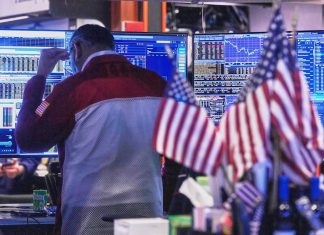The Australian Dollar (AUD) declines against the US Dollar (USD) on Wednesday after registering more than 0.25% gains in the previous session. The AUD/USD pair remains subdued as the AUD comes under downward pressure, driven by weakening global equities amid concerns over stretched artificial intelligence valuations, a move that weighed on sentiment for riskier currencies. Australia’s dependence on commodity exports amplified the impact, leaving the AUD vulnerable during periods of risk aversion.
Australia’s seasonally adjusted Wage Price Index rose 0.8% quarter-on-quarter in Q3, unchanged from the previous period and in line with forecasts. Annually, wages increased 3.4%, also matching both the previous quarter’s pace and market expectations.
Reserve Bank of Australia (RBA) published the Minutes of its November monetary policy meeting on Tuesday, indicating that board members signalled a more balanced policy stance, adding that it could keep the cash rate unchanged for longer if incoming data proves stronger than expected.
The AUD may regain support amid increased expectations for a cautious stance from the Reserve Bank of Australia (RBA), driven by stronger domestic employment data. As of the latest update on November 18, the ASX 30-Day Interbank Cash Rate Futures for December 2025 traded at 96.41, reflecting an 8% probability of a rate cut to 3.35% from 3.60% at the upcoming RBA Board meeting.
US Dollar holds ground amid fading Fed rate cut likelihood
- The US Dollar Index (DXY), which measures the value of the US Dollar against six major currencies, is holding ground and trading around 99.60 at the time of writing. The Greenback receives support from declining US Federal Reserve (Fed) rate cut bets for December.
- The CME FedWatch Tool suggests that financial markets are now pricing in a 49% chance that the Fed will cut its benchmark overnight borrowing rate by 25 basis points (bps) at its December meeting, down from 67% probability that markets priced a week ago.
- Federal Reserve Vice Chair Philip Jefferson noted Monday that risks to the labor market now outweigh upside risks to inflation, while stressing that the Fed should proceed “slowly” with any additional rate reductions.
- Kansas City Fed President Jeffrey Schmid said on Friday that monetary policy should “lean against demand growth,” adding that current Fed policy is “modestly restrictive,” which he believes is appropriate.
- US Department of Labor’s (DOL) released data on Tuesday showed that there were 232,000 Initial Jobless Claims in the week ended October 18. Continuing Claims came in at 1.957 million, up slightly from 1.926 million in the prior week. For initial claims, weekly data for the previous three weeks weren’t made available. Meanwhile, an Automatic Data Processing (ADP) report showed that employers cut 2,500 jobs a week on average during the four weeks ending November 1.
- National Economic Council Director Kevin Hassett cautioned that some October data may “never materialize,” as several agencies were unable to gather information during the shutdown. Initial private-sector reports suggest a cooling labor market and wavering consumer confidence, with persistent concerns about inflation.
- RBA Deputy Governor Andrew Hauser said last week, “Our best estimate is that monetary policy remains restrictive, though the committee continues to debate this.” Hauser added that if the policy is no longer mildly restrictive, it would have significant implications for future decisions.
- The Australian Bureau of Statistics (ABS) released the Unemployment Rate on Thursday, which declined to 4.3% in October from 4.5% in September, against the market expectations of 4.4%. Meanwhile, the Employment Change arrived at 42.2K in the same month from 12.8K (revised from 14.9K) prior, sharply exceeding the market forecast of 20K.
Australian Dollar remains below 0.6500 near nine-day EMA
The AUD/USD pair is trading around 0.6490 on Wednesday. The daily chart analysis indicates that the pair is consolidating within a rectangular range, signalling a period of sideways price action. Meanwhile, the price remains below the nine-day Exponential Moving Average (EMA), highlighting that bearish bias is active.
On the downside, the AUD/USD pair may find primary support at the lower boundary of the rectangle around 0.6470, followed by the five-month low of 0.6414, which was recorded on August 21.
The initial barrier lies at the psychological level of 0.6500, followed by the nine-day EMA of 0.6514. A break above this confluence resistance zone would improve the short-term price momentum and lead the pair to reach the rectangle’s upper boundary near 0.6630.

Australian Dollar Price Today
The table below shows the percentage change of Australian Dollar (AUD) against listed major currencies today. Australian Dollar was the weakest against the Japanese Yen.
| USD | EUR | GBP | JPY | CAD | AUD | NZD | CHF | |
|---|---|---|---|---|---|---|---|---|
| USD | -0.03% | 0.04% | -0.12% | 0.12% | 0.41% | 0.53% | 0.03% | |
| EUR | 0.03% | 0.07% | -0.09% | 0.15% | 0.44% | 0.55% | 0.06% | |
| GBP | -0.04% | -0.07% | -0.16% | 0.08% | 0.37% | 0.49% | -0.01% | |
| JPY | 0.12% | 0.09% | 0.16% | 0.24% | 0.53% | 0.63% | 0.15% | |
| CAD | -0.12% | -0.15% | -0.08% | -0.24% | 0.29% | 0.39% | -0.09% | |
| AUD | -0.41% | -0.44% | -0.37% | -0.53% | -0.29% | 0.12% | -0.37% | |
| NZD | -0.53% | -0.55% | -0.49% | -0.63% | -0.39% | -0.12% | -0.49% | |
| CHF | -0.03% | -0.06% | 0.00% | -0.15% | 0.09% | 0.37% | 0.49% |
The heat map shows percentage changes of major currencies against each other. The base currency is picked from the left column, while the quote currency is picked from the top row. For example, if you pick the Australian Dollar from the left column and move along the horizontal line to the US Dollar, the percentage change displayed in the box will represent AUD (base)/USD (quote).
Australian Dollar FAQs
One of the most significant factors for the Australian Dollar (AUD) is the level of interest rates set by the Reserve Bank of Australia (RBA). Because Australia is a resource-rich country another key driver is the price of its biggest export, Iron Ore. The health of the Chinese economy, its largest trading partner, is a factor, as well as inflation in Australia, its growth rate and Trade Balance. Market sentiment – whether investors are taking on more risky assets (risk-on) or seeking safe-havens (risk-off) – is also a factor, with risk-on positive for AUD.
The Reserve Bank of Australia (RBA) influences the Australian Dollar (AUD) by setting the level of interest rates that Australian banks can lend to each other. This influences the level of interest rates in the economy as a whole. The main goal of the RBA is to maintain a stable inflation rate of 2-3% by adjusting interest rates up or down. Relatively high interest rates compared to other major central banks support the AUD, and the opposite for relatively low. The RBA can also use quantitative easing and tightening to influence credit conditions, with the former AUD-negative and the latter AUD-positive.
China is Australia’s largest trading partner so the health of the Chinese economy is a major influence on the value of the Australian Dollar (AUD). When the Chinese economy is doing well it purchases more raw materials, goods and services from Australia, lifting demand for the AUD, and pushing up its value. The opposite is the case when the Chinese economy is not growing as fast as expected. Positive or negative surprises in Chinese growth data, therefore, often have a direct impact on the Australian Dollar and its pairs.
Iron Ore is Australia’s largest export, accounting for $118 billion a year according to data from 2021, with China as its primary destination. The price of Iron Ore, therefore, can be a driver of the Australian Dollar. Generally, if the price of Iron Ore rises, AUD also goes up, as aggregate demand for the currency increases. The opposite is the case if the price of Iron Ore falls. Higher Iron Ore prices also tend to result in a greater likelihood of a positive Trade Balance for Australia, which is also positive of the AUD.
The Trade Balance, which is the difference between what a country earns from its exports versus what it pays for its imports, is another factor that can influence the value of the Australian Dollar. If Australia produces highly sought after exports, then its currency will gain in value purely from the surplus demand created from foreign buyers seeking to purchase its exports versus what it spends to purchase imports. Therefore, a positive net Trade Balance strengthens the AUD, with the opposite effect if the Trade Balance is negative.







